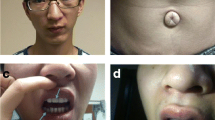Abstract
X/X translocations are quite rare in humans. The effect of this anomaly on the phenotype is variable and depends on the amount of deleted material and whether the chromosomes are joined by their long or short arms. We report an unusual case of Turner syndrome mosaicism in a 16-year-old girl, who was referred to our Institute for primary amenorrhoea associated with short stature. Endocrine evaluation revealed hypergonadotropic hypogonadism, which required a study of the karyotype. Cytogenetic analysis, performed on peripheral blood leucocytes, showed a mos 45,X/46,X,ter rea (X;X)(p22.3;p22.3) de novo karyotype. The prevalent cell line was 45,X (90% cells). A second cell line (10% cells) showed a very large marker chromosome, similar to a large metacentric chromosome. FISH (fluorescent in situ hybridisation) and molecular analysis revealed that the marker chromosome was dicentric and totally derived from the paternal X chromosome.
Similar content being viewed by others
References
Allen RC, Zoghbi HY, Moseley AB, Rosenblatt HM, Belmont JW, 1992. Methylation of HpaII and HhaI sites near the polymorphic CAG repeat in the human androgen-receptor gene correlates with X chromosome inactivation. Am J Hum Genet 51: 1229–1239.
Figueiredo CC, Kochi C, Longui Ca, Rocha MN, Richeti F, Evangelista Nm, et al. 2008. Size of the exon 1-CAG repeats of the androgen receptor gene employed as a molecular marker in the diagnosis of Turner syndrome in girls with short stature. Genet Mol Res 7: 43–49.
Rivera H, Sole MT, Garcia-Cruz D, Wilson M, Cantu JM, 1984. On telomere replication and fusion in eukaryotes: apropos of a case of 45,X/46,X,ter rea(X;X)(p22.3;p22.3). Cytogenet Cell Genet 38: 23–28.
Shaffer LG, Tommerup N, 2005. An International System for Human Cytogenetic Nomenclature, eds., S. Karger, Basel.
Stoll C, Lausecker Ch, Pennerath A, 1979. A girl with an end-to-end fusion of two X’s. Eur J Pediatr 131: 141–45.
Sullivan BA, Willard HF, 1998. Stable dicentric X chromosomes with two functional centromeres. Nat Genet 20: 227–228.
Sybert VP, McCauley E, 2004. Turner’s syndrome. N Engl J Med 351: 1227–1238.
Uematsu A, Yorifuji T, Kawai M, Mamada M, Kaji M, Yamanaka C, et al. 2002. Parental origin of normal X chromosomes in Turner syndrome patients with various karyotype: implications for the mechanism leading to generation of a 45,X karyotype. Am J Med Genet 111: 134–139.
Wiktor A, Van Dyke DL, 2004. FISH analysis helps identify low-level mosaicism in Ullrich-Turner syndrome patients. Genet Med 6: 132–135.
Wiktor AE, Van Dyke DL, 2005. Detection of low-level sex chromosome mosaicism in Ullrich-Turner syndrome patients. Am J Med Genet 138: 259–261.
Author information
Authors and Affiliations
Corresponding author
Rights and permissions
About this article
Cite this article
Nucaro, A.L., Melis, P., Casini, M.R. et al. Turner syndrome mosaicism: an unusual case with a de novo large dicentric marker chromosome: mos 45,X/46,X, ter rea(X;X)(p22.3;p22.3). J Appl Genet 49, 301–303 (2008). https://doi.org/10.1007/BF03195627
Received:
Accepted:
Issue Date:
DOI: https://doi.org/10.1007/BF03195627




